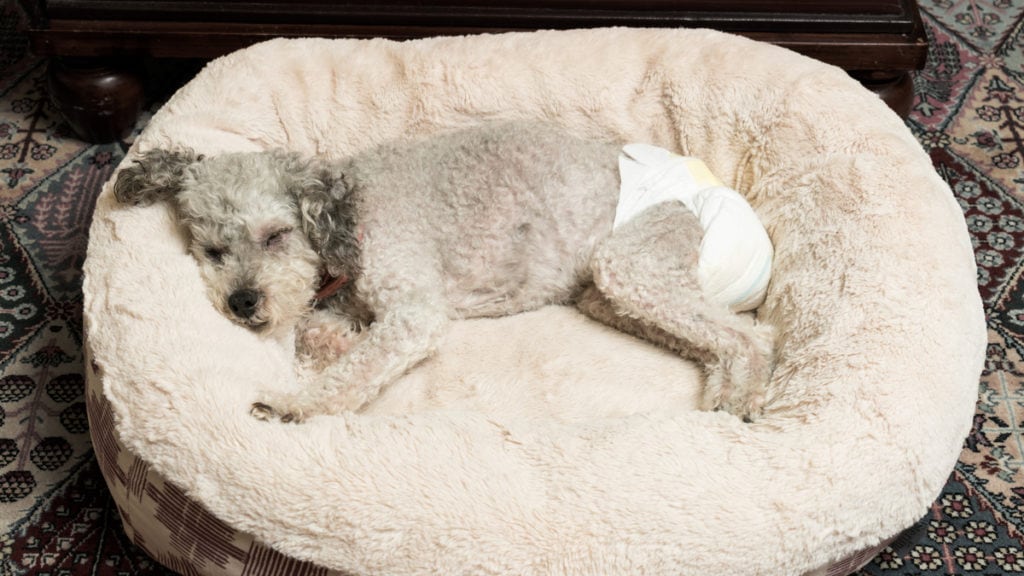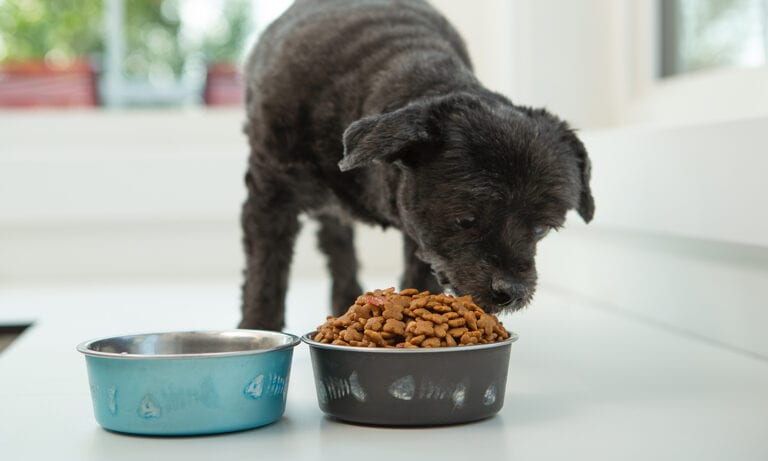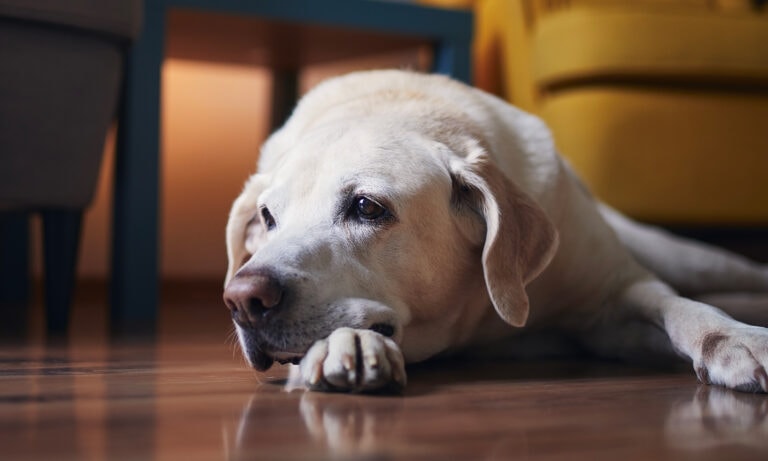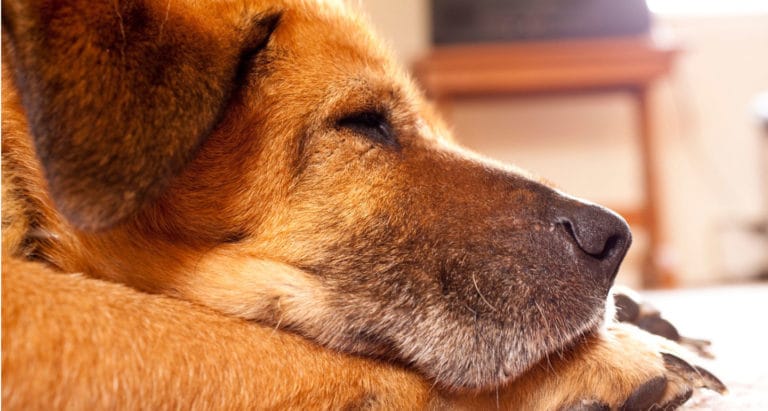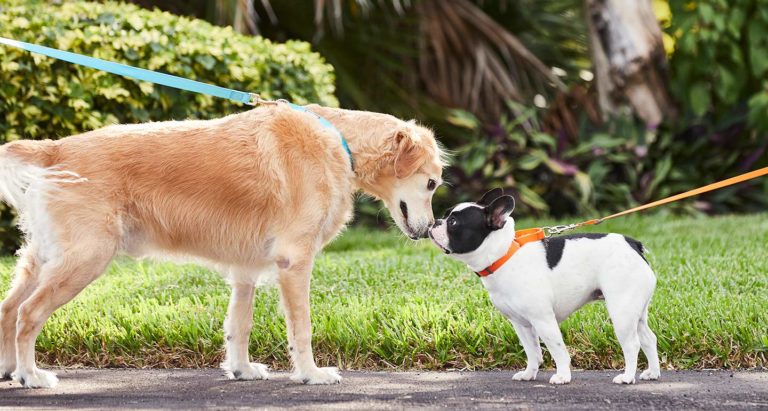Urinary incontinence is the leaking of urine from the bladder. A dog with this condition may commonly be seen licking the vulva or penis area. A normal dog can easily control the action of passing urine, but urinary incontinence is involuntary or uncontrollable. The condition manifests when a previously housebroken dog loses control of his or her bladder, which results in occasional small urine leaks or even voiding of a large amount of urine. This can happen to dogs of any age.
In senior dogs, there are many potential causes for loss of bladder control. Some of the more common are hormonal imbalance, weak bladder sphincter tone, urinary tract infections possibly involving stones, and spinal injuries or degeneration. And, as is the case in my older dog Josie, the incontinence can be a combination of age-related (senility), as well as a loss of muscle tone and also leakage due to excitement.
Signs Of Trouble And Dogs At Risk
The general symptoms of urinary incontinence in these senior dogs is dripping urine, which can irritate the skin and cause redness to the skin. There is also increased or excessive licking of the vulva or penis area. Owners of these dogs may also notice the area where the dog sleeps is wet and malodorous because of the urine leakage.
Although urinary incontinence can afflict dogs of any age, breed or gender, it is most often seen in middle-aged to older, spayed female dogs. Cocker Spaniels, Springer Spaniels, Doberman Pinschers and Old English Sheepdogs are among the breeds that seem to be more prone to incontinence. Hormone-responsive incontinence is more common in female dogs than it is in males, and more common in neutered and spayed dogs than in intact ones. Older dogs tend to be more prone to developing this condition.
Is It Truly Incontinence?
When a dog is suspected of incontinence, an important first step is to establish that the problem really is incontinence and not just an increase in the need to urinate, which causes the dog to urinate in the house because he must. Disorders that increase the amount of urine produced, and therefore the need to urinate, include diabetes mellitus, hyperadrenocorticism (Cushing’s disease), diabetes insipidus, uterine infections, kidney failure, administration of corticosteroids and some other medications, and other more infrequent causes.
Always let your vet know if your dog is drinking more than normal and urinating larger volumes than normal.
There are also diseases and disorders that increase the urge or need to urinate without an increase in actual urine volume. These include cystitis, bladder stones or stones elsewhere in the urinary tract, cancer in the urinary tract and prostate disease in males.
Problems Caused By Dog Incontinence
Dogs suffering from urinary incontinence have some common secondary problems. They have a much higher incidence of bladder infections. It is believed that with the more relaxed opening to the bladder, it is easier for bacteria to migrate up the urethra and colonize the bladder. These dogs may need to be on antibiotics until the incontinence is dealt with.
Dogs with urinary incontinence frequently suffer from urine scalding. Urine is fairly caustic, and if it remains in contact with the skin for long periods of time, it can cause severe irritations. Scalded areas are usually treated topically with anti-inflammatory salves that also contain antibiotics.
Dogs who do not respond 100 percent to medication may still leak urine in small quantities. If this is the case, dog diapers or panties with absorbent pads can be used to soak up the urine. Some people use human disposable diapers and cut out a hole for the tail.
Diagnosis And Treatment
If you think your dog may be incontinent, consult a veterinarian. He or she will confirm the diagnosis and try to determine a cause. The vet will take a thorough history, perform a physical exam and likely conduct a urinalysis to verify whether your dog is suffering from a urinary tract infection that requires treatment with antibiotics. Other tests may include a urine culture, blood work, radiographs (X-rays) and possibly an ultrasound.
Treatment for incontinence depends on its underlying cause. Medications can often effectively manage this condition and prevent everyday accidents. Some treatments focus on hormone therapy, while others strengthen the urethral sphincter, which controls urine flow. Surgery also may be an option if medication alone does not work. Collagen injections, a newer therapy for incontinence, appear to have promising results. In cases of incontinence due to bladder stones, a protruding disc or congenital abnormality, surgery may be recommended.
Blame It On Hormones
Because the cause of urinary incontinence is often a hormone deficiency, replacements with hormones or hormone substitutes may also be prescribed. After a brief period of daily doses, it is usually given once a week. At the minute levels used to treat incontinence in dogs, side effects are extremely rare. Dogs with hormone-responsive incontinence will need to remain on such medication for the rest of their lives.
In a spayed female dog in which incontinence shows up after the surgery, it is very tempting to ignore other possible causes and treat for this one, especially because it can be pretty expensive to test for all possible causes. In a dog in which incontinence is not responsive to therapy, or when there are reasons to suspect other causes may be present, it is important to know what other issues can lead to incontinence and to eliminate as many of them as possible through appropriate testing.
Incontinence Not Caused By Hormones
There are also a number of disorders that are considered to be forms of incontinence that are not related to estrogen levels.
1. Neurologic disorders affecting the nerve supply to the bladder can lead to incontinence. There are several classes of these disorders. In general, the bladder is large and distended due to the loss of nerve function. This is a hint that there may be neurologic causes. Many veterinarians may not feel confident in their ability to diagnose neurogenic bladder disorders. If these are suspected, it may be necessary for a neurologist to help in the diagnostic process.
2. Large bladders can also be a sign of an obstruction to urine flow downstream of the bladder, such as a urolith (stone) in the urethra, especially in a male dog. Any bladder stone can cause or make it seem like cystitis or incontinence is present, both by mechanically obstructing the urinary tract, and by irritating it to create a better environment for bacterial infection.
3. Some dogs are born with their ureters, the tubes that connect the kidneys to the bladder, misplaced. When this happens it may lead to continuous urine leakage, especially if the ureters miss the bladder entirely and implant directly into the urethra.
4. There are also dogs with behavioral incontinence. Stress or excitement can lead to urine leakage. Another behavioral condition some dog owners confuse with incontinence is submissive urination. This is a form of voluntary urination that occurs when a dog is very submissive, so it is not truly incontinence. These dogs usually roll over when approached, show their undersides and urinate a little, or sometimes a lot.
5. Rarely, urinary incontinence can occur in younger animals due to congenital anatomic abnormalities.
6. Infrequently, older dogs may have urinary incontinence due to tumors or polyps in the bladder. Injury of nerves going to the bladder can also cause incontinence. Prostate disease may also result in incontinence.
Living With Dog Incontinence
To help manage urinary incontinence, lay out clean dog blankets and towels in your dog’s favorite sleeping spot, or put waterproof pads under the bedding to absorb any moisture. To avoid urine buildup, take your dog for more frequent walks — including first thing in the morning, shortly after he wakes from a nap and last thing at night. Dog diapers are an option and are available at many pet retailers. I typically do not recommend cutting back on water availability and would definitely consult with your vet before limiting your dog’s water intake. It will be very important to provide proper hygiene to prevent any related skin irritation and/or infections. And, especially with older dogs, you need to monitor your dog’s condition closely, because skin irritation can quickly accelerate to infection.
Though incontinence can be frustrating both for you and your pet, in many instances a cause can be determined and it can be treated. Getting the help of a veterinarian will help with your dog receiving the most effective treatment.
By: Dr. Byron de la Navarre
Share:
